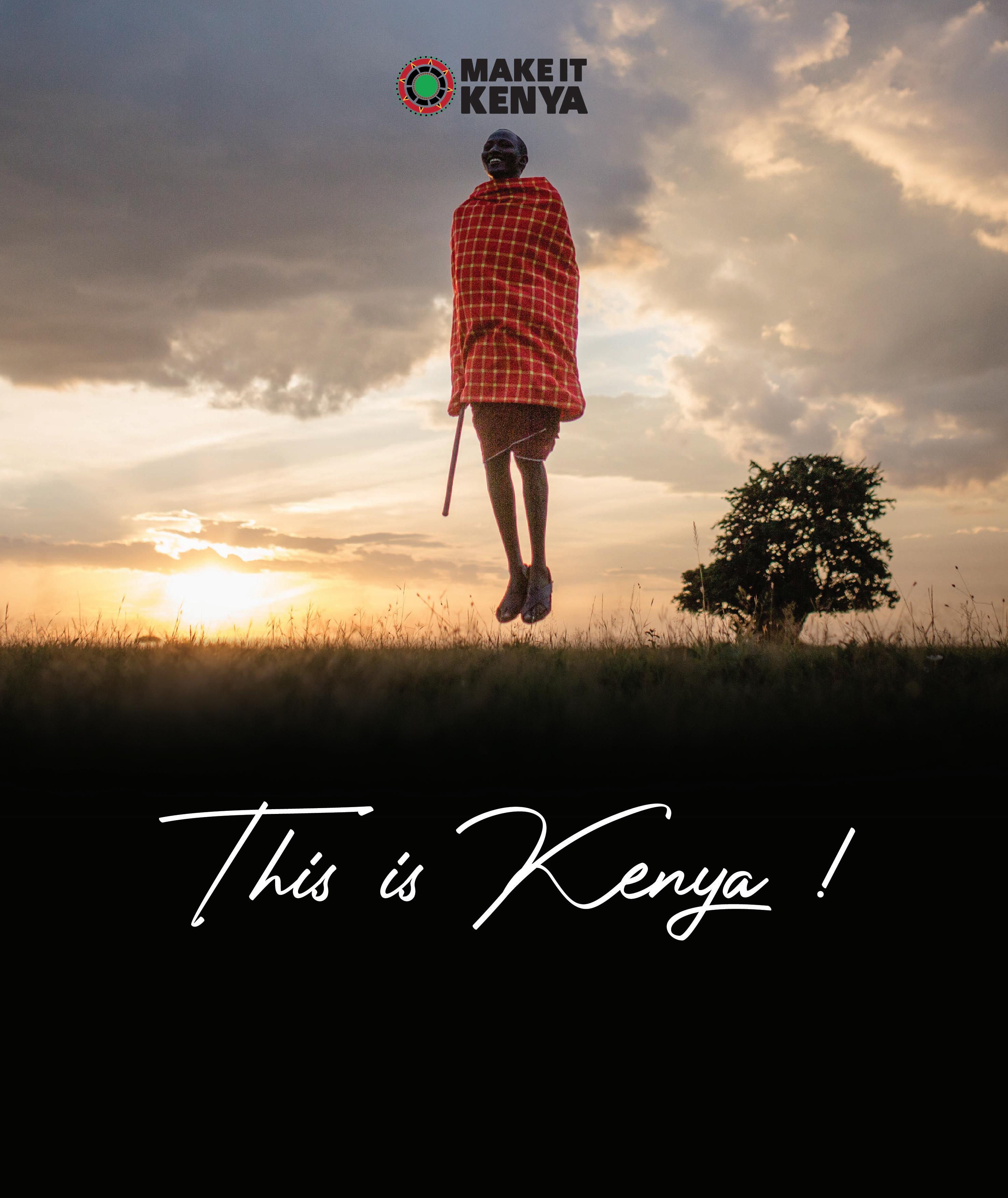
SECTION 1:
KENYA
TRIBES……………………………………………………………….........................................................………………………4
GLOBAL RANKING……………………………………..............................................…………………………………4
GROSS DOMESTIC PRODUCT (GDP)………………….....................………………………………..4
REGIONAL ECONOMIC COMMUNITIES………….....…………………………………………..........4
CITIES…………………………………………………………………..…….........................................................……………...5

ECONOMY……………………………………………………………....................................................………………….…5
KEY LANDMARKS IN KENYA……………………………...................................…………………….…………5
KENYA IS THE HOME OF SPORTS……………………………..........................…………………..…….6
CULTURAL AND POLITICAL FIGURES IN KENYA………….........………………….………..7
SECTION 2:
WHY CHOOSE KENYA……………………………….........................................................…….………….……8
INNOVATION DRIVER AND ICT INVESTMENTS………………..........…………………….…..9
GLOBAL DIPLOMATIC CAPITAL AND LEADERSHIP………………...……………..…….9 HIGHLY DEVELOPED PHYSICAL INFRASTRUCTURE…………………………………..9 KENYA, A LOGISTICAL HUB……………………………………..................................………………………9
MARKET ACCESS…………………………………………………………..........................................……………….10
INTERNATIONAL AIR ACCESS…………………………………..............................………………………10
VIBRANT MANUFACTURING SECTOR…………………..............…………………………………..10
GREEN ENERGY AND POWER…………………………………….......................………………………….10
SUSTAINABLE BLUE ECONOMY…………………………………...................…………………………..10
WELL EDUCATED AND PROFESSIONAL HUMAN CAPITAL…………..........................................................................................................................…………………..10
DIVERSE INSTITUTIONS OF HIGHER LEARNING……………………………………………11
FINANCIAL
HEALTH
INWARD
SECTION
OTHER
SECTION 5:
KEY ATTRACTIONS
KEY ATTRACTION
CULTURE
SECTION 6:
VISIT,
EXPORT OF SERVICES………………………………………………………......................................………..………17
SERVICES…………………………………..............................…………………………..17 EDUCATION SERVICES……………………………………...........................…………………..……..17 ICT…………………………………………………………………....................................................……..……………17
SERVICES………………………………...............................………………………...………….17 TRANSPORT SERVICES………………………...........................…………………………………….17 INSURANCE...........................................................................................................................................18
INVESTMENTS……………………………............................………………………………18
4:
OPPORTUNITIES FOR INVESTMENTS………………...............................………….…..19 MINING SECTOR………………………………………………………..................................………………20 BLUE ECONOMY……………………………………………….……................................……..………….20 VALUE ADDITION……………………………………………………...............................….………..……20 SPECIAL ECONOMIC ZONES………………………………...................…..………………..….20 AGRICULTURE………………………………………………………..................................………………….20 ENERGY…………………………………………………………………...........................................……………..20 MANUFACTURING………………………………………………................................……………………20
IN KENYA…………………………………....................................................………,…….21 TOURISM……………………………………………………………………………......................................................………,….22
CENTRES……………………………………...............................………….………………..22
AND HERITAGE………………………………...................................…………………………………….22
TOUR, INVEST AND TRADE WITH US!...............................................................23 - 26
IS THE LAND OF UNLIMITED POSSIBILITIES……….......................……………3 KENYA AT A GLANCE………………..........................................……………………………………………………4 LOCATION…………………………………………......................................................………………………………………4 NEIGHBORS…………………………………………………...................................................……………………………..4 POPULATION AND DEMOGRAPHICS…………………......................……………………………….4 OFFICIAL LANGUAGE…………………………………………………........................................………………...4 CLIMATE…………………………………………………………………….......................................................………………4 POLITICAL SYSTEM………………………………………….........................................…………………………….4
CONDUSIVE BUSINESS ENVIRONMENT…………………...........…………………..……………..11 SECTION 3: KEY EXPORT PRODUCTS AND SERVICES…………..........................………………………....12 FLOWERS………………………………………………………………….................................……………13 VEGETABLES……………………………………………………………….............................…………..13 FRUITS……………………………………………………………………………..................................……...13 NUTS……………………………………………………………………………….....................................…….14 MACADAMIA NUTS……………………………………………………........................……………14 CASHEW NUTS……………………………………………………….........................………………..14 TEA…………………………………………………………………………........................................…………..14 COFFEE…………………………………………………..................................……………………………...15 TEXTILE………………………………………………………………….................................…….……….…15 LIVESTOCK…………………………………………………………………..............................…..…….…15 MEDICAMENTS…………………………………………………………..........................……..……….16 TABLE OF CONTENTS Art and Illustrations : Walter Kelvin Otieno A Kenya Export Promotion and Branding Agency Production ©2022
KENYA AT A GLANCE
LOCATION
Kenya is a country located in Eastern Africa. At 580,367 square kilometres, Kenya is the world’s 48th largest country by area. It has 47 Counties which include Mombasa, Kwale, Kilifi, Tana River, Lamu, Taita Taveta, Garissa, Wajir, Mandera, Marsabit, Isiolo, Meru, Tharaka-Nithi, Embu, Kitui, Machakos, Makueni, Nyandarua, Nyeri, Kirinyaga, Muranga, Kiambu, Turkana, West Pokot, Samburu, Trans Nzoia, Uasin Gishu, Elgeyo Marakwet, Nandi, Baringo, Laikipia, Nakuru, Narok, Kajiado, Kericho, Bomet, Kakamega, Vihiga, Bungoma, Busia, Siaya, Kisumu, Homa Bay, Migori, Kisii, Nyamira, and Nairobi.
NEIGHBOURS
Kenya is bordered to the North by South Sudan and Ethiopia, to the East by Somalia and the Indian Ocean, to the South by Tanzania, and to the West by Lake Victoria and Uganda.
POPULATION AND DEMOGRAPHICS
Kenya has a population of 56 million people (2022) spread across 44 tribes. It is ranked the 4th largest economy in Sub-Saharan Africa. Kenya ranks number 28 in the list of countries (and dependencies) by population.
The population density in Kenya is 90 per Km2 (232 people per mi2).The median age in Kenya is 19.2 years with the age structure being:
0-14 years: 40.02%
• 15-35 years: 35%
36-64 years: 21.98%
65 years and over: 3%
OFFICIAL LANGUAGE
Kenya’s official language is English and Swahili. In addition, the various ethnic groups from all the 44 tribes typically speak their mother tongues within their own communities.
CLIMATE
Generally, Kenya’s climate is warm and humid at the Coast, cool and humid in the Central highlands, and hot and dry in the North and East. Visitors and delegates are able to enjoy most activities in the cities, beaches and in the national parks all year round.

POLITICAL SYSTEMS
Kenya has a Devolved State with Multiparty Democracy and is home to 47 counties. Kenya lies on the equator and a climate range from tropical to temperate (10° to 40°c).
TRIBES
Kenya has 44 tribes which makes it unique in cultural diversity. The 44 different ethnic groups have different languages and dialects, traditional arts and crafts, architecture in homestead designs, clothing and jewellery, food, social and economic activities.
GLOBAL RANKING
Kenya is ranked 56th out of 190 economies in the Ease of Doing Business Index with an ambitious plan to reach top 50 in the next 3 years.
Kenya is among the world’s emerging economies to invest in, due to its accelerated infrastructure development and a stable political and macroeconomic environment.
GROSS DOMESTIC PRODUCT (GDP)
Kenya is ranked 4th largest economy in Sub-Saharan Africa .The World Economic Forum’s country competitiveness report ranks Kenya 1st in Africa in quality of human capital, availability of research, innovation and business dynamism, making it the place to be as an investor.
Kenya’s GDP in 2021 = USD 110.3 Billion, Our GDP per Capita growth is 5.1%
FDI inflows in 2020 = USD 426.31 Million
Kenya’s GDP per Capita in 2021 = USD 1643.6, Our GDP growth in 2021 = 7.5%
REGIONAL ECONOMIC COMMUNITIES
Kenya is a member of the East Africa Community (EAC) with population of about 466 million, Common Market for Eastern and Southern Africa (COMESA) with population of about 560 million, and the Africa continental free trade area (ACFTA) that guarantees a market of over 1.5 billion people. Kenya also has preferential market access to a population of over 700 million in EU; and a population of 455 million in USA with export opportunities to over 6,000 product lines under the AGOA arrangement.
56 MillionEast Africa
This is Kenya 4
Nairobi
Nairobi is the capital and largest city of Kenya. Nairobi is a vital commercial and financial regional hub and home to the regional headquarters of various major international companies and organizations United Nations Headquarters.
Mombasa
Mombasa is a coastal city in south-Eastern Kenya along the Indian Ocean. It is the country’s oldest and second-largest city. Mombasa is a tourismbased town with an extra-large port and an international airport.
Kisumu
Kisumu is a Kenyan port city on Lake Victoria. It is the largest and most important city in Western Kenya. Kisumu serves as a trading and transportation hub for the Great Lakes region in Western Kenya.
Nakuru
Nakuru is the fourth-largest urban center in the Rift Valley region of Kenya. Former President Uhuru Kenyatta awarded a city charter to Nakuru in December 2021 making it the fourth city in the country.

ECONOMY
Kenya operates a liberal economy which promotes trade and investment. Real Gross Domestic Product (GDP) grew by 7.5 per cent in 2021.
The country has abolished price and exchange controls. The Government has also instituted measures to sustain macro-economic stability such as prudent fiscal and monetary policies, improvements in economic governance, and privatization of some public enterprises. These policies continue to promote growth by providing a more secure environment for private sector investment decisions.
KEY LANDMARKS IN KENYA
1. Mount Kenya
Mount Kenya strategically lies at the heart Kenya and provides breathtaking views for visitors from all over the world. The highest peak of this famous Kenyan landmark is 5,199 meters tall, making it the second-highest peak in all of Africa after Kilimanjaro.
Mount Kenya is a Kenya landmark that is a very popular tourist attraction for both local and international visitors to Kenya. Mount Kenya National Park, a forest reserve home to various flora and fauna, surrounds the mountain.
It is home to many animal species, including elephants tree hyrax, white-tailed mongoose, black-fronted duikers, mole rats, bushbucks, waterbucks, elands, leopards, black rhinos and buffaloes.
2. Lake Victoria
Also known as the second-largest freshwater lake globally, Lake Victoria is one of the famous landmarks of Kenya.
Its surface area spans over 68,000 square kilometres and is the largest lake in Africa. The lake provides many opportunities for tourism throughout its Kenyan, Tanzanian and Ugandan sides.
3. The Maasai Mara
This world-famous game reserve is in southwestern Kenya and is one of the most popular tourist destinations in the country. The Maasai Mara covers an area of 1,510 square kilometres and is home to many animal species, such as lions, cheetahs, leopards, giraffes, buffalo, eland antelopes and elephants.
4. The Great Rift Valley
This world-famous valley stretches along the eastern side of Africa and is a well-known landmark in Kenya. It includes many lakes, extinct volcanoes, and other geographical formations.
One of the most famous landmarks within the Great Rift Valley is Lake Naivasha, Hell’s Gate National Park, which forms part of the valley.
Hell’s Gate has many exciting features including
•
Geothermal Valley – a geothermal area full of boiling springs and steam vents
• Olkaria Geothermal Station – the largest in Africa
• Vultures’ Cliff – where vultures can be seen nesting on the cliffs
5. Lamu Archipelago
This is a group of islands located off the coast of Kenya and is one of the country’s most popular tourist destinations.
The archipelago comprises of Pate Island, Lamu Island, Manda Island and Kiwayu Island.
Visitors to this archipelago enjoy many activities, such as sunbathing, swimming, snorkelling and diving.
One of the most famous landmarks in Kenya, Lamu Old Town, is also on these islands and allows visitors to explore its historical buildings and scenery.
This is Kenya 5 CITIES
6
6. Fort Jesus
This historic Fort is in the coastal city of Mombasa and was built by the Portuguese in 1593.
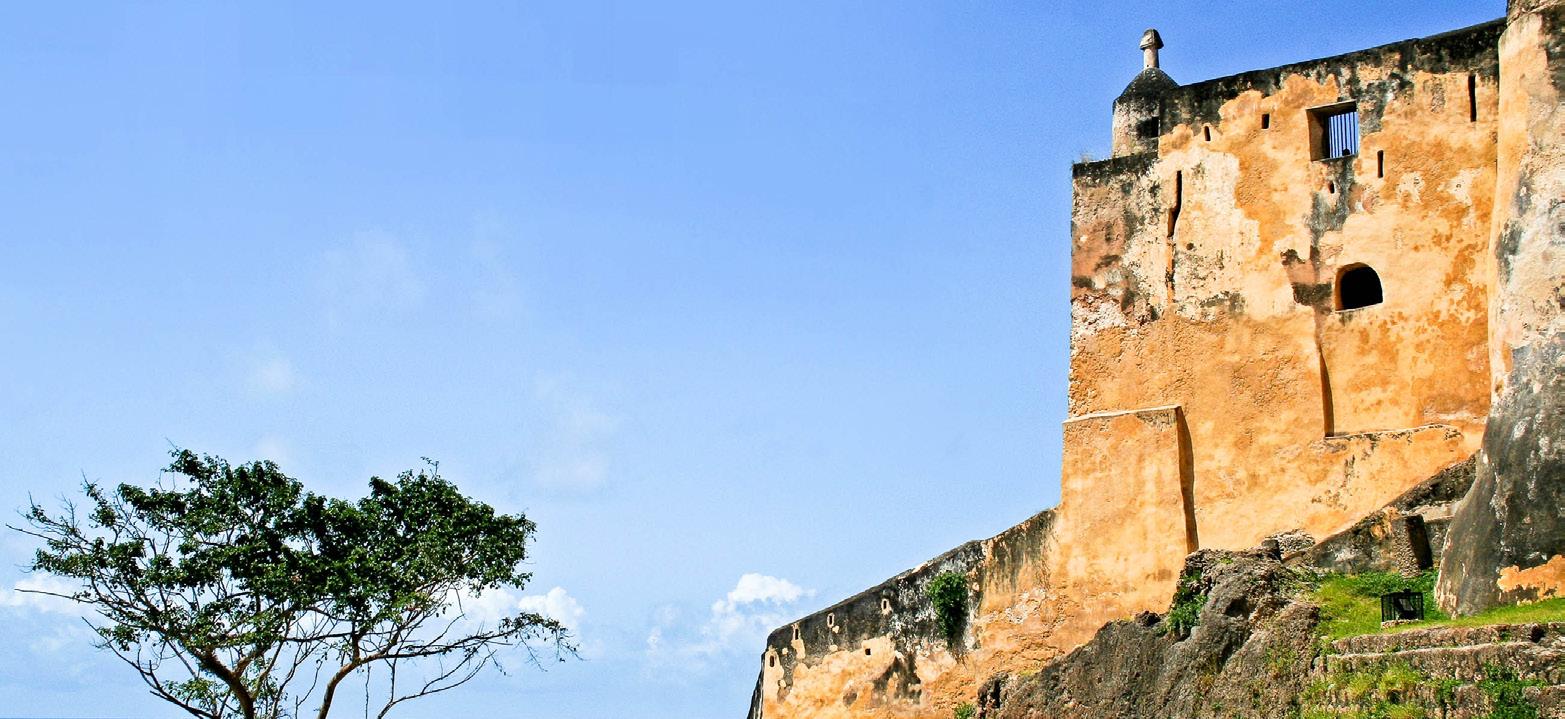
It is one of Kenya’s most popular tourist destinations and is a UNESCO World Heritage Site.
We know fort Jesus for its many features, such as:
• The Pier – which extends out into the ocean and was used to dock ships.
• The Barracks – which were used to house the fort’s soldiers.
• The Cathedral – which was used for prayer and worship.
• The Prison – which was used to detain prisoners.
• The Roofs were used to provide shelter for the soldiers and their families.
7. KICC Tower
At the heart of Nairobi Central Business District is KICC Tower, or Kenyatta International Convention Centre Tower. It was once the tallest building in Kenya and offered beautiful views of Nairobi.
The tower was completed in 1973 and has a height of 105 meters.
It is used as a convention centre for most local and international meetings, office building, and hotel.
The KICC Tower is a popular tourist destination for those visiting Nairobi and is a great place to view the cityscape.
8. Tsavo National Park
The Tsavo National Park is Kenya’s largest and oldest national park and offers some of the country’s best safari opportunities.
It spans an area of 8,200 square kilometres and is home to many animals including Lions, Leopards, Buffaloes, Giraffes, and cheetahs.
The Park has many other features including:
• Mzima Springs–one of the largest freshwater springs in Kenya and is home to a variety of fish and crocodiles.
• Tsavo River–a large river that runs through the national park and offers spectacular views of hippos and crocodiles.
• Kanderi Swamp–home to many types of waterbirds.
• Mudanda Rock–a popular destination for rock climbers.
• Elephant Watch Hill has some of the best views of elephants in the park.
KENYA AS A HOME OF SPORTS
Sport is an important element of the Kenyan culture. Globally, Kenya is mainly known for its dominance in middle-distance, long-distance races. Sports in Kenya are played both professionally and as recreational physical activities. Sports played in Kenya include athletics (track & field and other running events), cricket, field hockey, motor sports, football, rugby, volleyball, basketball, swimming and diving, handball, netball, bicycling and martial arts.
ICONIC SPORTSMEN AND WOMEN
FERDINAND OMANYALA - 100M
• Fastest man in Africa.
• Kip Keino classic champion.
• 8th fastest man of all-time. African record holder.
ELIUD KIPCHOGE - MARATHON
Olympic champion.
• Greatest marathoner of all time.
• 1st human to run a sub-two-hour marathon.
EZEKIEL KEMBOI- 3000M STEEPLECHASE
Multiple Olympics Champion.
JULIUS YEGON- JAVELIN
• 1st commonwealth javelin record holder.
BRIGID KOSGEI - MARATHON
• Women Marathon Record Holder.
HELLEN OBIRI - 5000M

2016 Rio Olympics Champion.
FAITH CHEPNGETICH KIPYEGON - 1500M
2016 Rio Olympic champion.
• 2020 Tokyo Olympic champion
MICHAEL OLUNGA – FOOTBALL
• Striker for Qatari club Al-Duhail. Also plays for the Kenya national team.
This is Kenya
VICTOR WANYAMA - FOOTBALL
• Defensive midfielder for major league soccer club CF Montréal.
• First Kenyan to play in the Premier League
Previously played for Beerschot, Celtic, Southampton and Totten ham Hotspur.
NATIONAL TEAMS
• Kenya morans – Basketball.
• Malkia strikers – volleyball.
• Shujaa – Rugby.
Harambee Starlets – Football
• Harambee stars – Football.
CULTURAL AND POLITICAL FIGURES IN KENYA
JOMO KENYATTA
He is regarded as the Founding Father and the first president of the Republic of Kenya. He preached a doctrine of personal and entrepreneurial effort, symbolized by his slogan “Harambee,” or “Pulling together.”
DANIEL TOROITICH ARAP MOI

He served as the second president of Kenya from 1978 to 2002. He was the country’s longest-serving president. One of Moi’s enduring policy imprints is in education. His education reforms aimed at addressing ethnic disparities in university access among marginalized communities.
MWAI KIBAKI
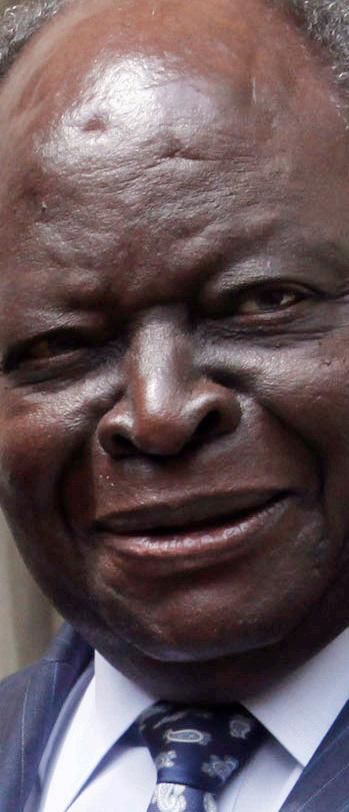
Kibaki was the third President of the Republic of Kenya. Under his stewardship, the economy blossomed, with the gross domestic product (GDP) rising from a lowly 0.6% to an impressive 7% in his first term. The construction of the 45-kilometre Thika Superhighway would become the symbol of success in the development of infrastructure. He also launched the Free Primary Education programme, boosting enrolment in schools and curbing high dropout rate due to lack of school fees.
UHURU KENYATTA

He was the fourth President of the Republic of Kenya. He was the first president under the new 2010 Constitution, overseeing devolution enabling him to set precedents and standards for future presidents. He advanced infrastructural developments such as constructing roads and railways as well as building and expanding airports and seaports.
DEDAN KIMATHI
Widely regarded as a revolutionary leader, he led the armed military struggle against the British colonial regime in Kenya.
WANGARI MAATHAI

Prof. Wangari Maathai was a Kenyan Environmentalist and Human Rights Activist. She was the first African woman to receive the very prestigious Nobel Peace Prize of 2004. Maathai fought tirelessly, even against oppressive regime, to ensure a sustainable environment and better quality for women and the citizens of Kenya.
NGUGI WA THIONGÓ


As a writer, playwright, journalist and lecturer Ngugi wa Thiong’o has been widely regarded as East Africa’s most influential writer. Ngugi has published and wrote stories, plays and novels. His most famous novels are Weep Not Child (1964), The River Between (1965) the Grain of Wheat (1967) and Petals of Blood (1977).
RICHARD LEAKEY
He was Director of the National Museum of Kenya, Director of the Kenyan Wildlife Department, served as head of Kenya’s civil services and secretary of the Cabinet. Richard Leakey established Wildlife Direct to create a direct relationship between those at the front line of conservation and those who care about wildlife anywhere in the world.
LUPITA NYONGÓ

Lupita is a Kenyan actress who won an Oscars Academy Award for her film debut in 12 Years a Slave (2013). She is the recipient of several accolades, including a Daytime Emmy Award, four NAACP Image Awards, and two Screen Actors Guild Awards. Additionally, she has been nominated for a Primetime Emmy Award and a Tony Award.
TOM MBOYA


He was a Kenyan trade unionist, educator, Pan-Africanist, author, independence activist, and statesman. He was one of the founding fathers of the Republic of Kenya.
MO AMIN
Mohamed Amin was a Kenyan photojournalist known for delivering world exclusive images, and stories at the forefront of journalism in Africa.

PROF. MIRIAM WERE
She is a public health advocate, academician, and recipient of the first Hideyo Noguchi Africa Prize. She was nominated for the Nobel Peace Prize 2022 for her contribution in public health.
This is Kenya 7
SECTION 2:


WHY CHOOSE KENYA

DRIVER AND ICT INVESTMENTS
The Government of Kenya identified ICT as a key enabler to the attainment of the goals and aspirations of the Vision 2030. The country boasts of the following
• Great innovation in ICT e.g. MPESA which has revolutionized the financial sector.
• Vibrant and highly tech savvy youthful population, 2nd largest in Africa.
• Hosts the best incubation centres in the region e.g. I Hub, I-lab and IBM Centre.
• Kenya is a key source of talent as demonstrated by the wide array of technology companies that have set up their regional bases in Kenya to tap into the talent.
• Kenya boasts of the best internet coverage and technology infrastructure across Africa.
• Konza (Konza Technopolis) is a key flagship project of Kenya’s Vision 2030 economic development portfolio. Konza will be a world-class city, powered by thriving information, communications and technology (ICT) sector, superior reliable infrastructure and business friendly governance systems.
GLOBAL DIPLOMATIC CAPITAL AND LEADERSHIP
The United Nations Office at Nairobi (UNON) in Nairobi, is one of four major United Nations office sites. It is the UN’s official headquarters in Africa.
The United Nations Office at Nairobi also hosts the global headquarters for two programmes: the United Nations Environmental Programme (UNEP) and the United Nations Human Settlements Programme (UN-Habitat).

Other major international agencies include Food and Agriculture Organization, International Labour Organization, UN Women, United Nations Development Programme, UNHCR, World Bank, international Monetary Fund, World Food Programme, WHO etc.
In January 2021, Kenya assumed membership to the UN security council as a non-permanent member for a 2-year non-renewable stint. Kenya’s success arguably stemmed from a widely shared perception of its stature as a stable role model on the continent, particularly East Africa, within which it stood out as the region’s most developed and influential power.
HIGHLY DEVELOPED PHYSICAL INFRASTUCTURE
• Fortune magazine named Kenya as the best African emerging economy to invest due to accelerated infrastructure development and a stable macro-economic environment.
• Kenya co-funded several priority infrastructures projects and enhancing Trade and Regional Integration in East Africa.
• Nairobi – Mombasa Standard Gauge Railway completed in 2017, has hit over 2m passengers with a revenue earning estimation of Sh15bn.

• Transforming Kenya into a maritime hub with development of US$267m in Mombasa through the LAPSSET Project for Regional growth.
• Construction by the Kenya Pipeline Company of a US$489m construction of the Mombasa-Nairobi multi-product pipeline.
• New roads are being constructed in every county; Corridors, Highways and by-passes.
• Railways stations under construction – 27 expected for Nairobi City alone
• USD 3.6 billion Standard Gauge Railway links Kenya’s Indian Ocean port city of Mombasa to the capital Nairobi.
• USD 654 million Jomo Kenyatta International Airport expansion comprises of a 178,000m2 facility, complemented by Nairobi Commuter Rail Service linking the city centre to the airport.
• USD 366 million The Port of Mombasa harbour channel was deepened by 15 metres and widened to 500 metres to accommodate larger vessels.
• The Nairobi Expressway, a toll road that connects Jomo Kenyatta International Airport to other sections in Nairobi.
KENYA, A LOGISTICAL HUB
Transport and logistics is at the core of Kenya’s economic narrative due to the country’s role as a trans-shipment hub for goods moving to landlocked countries in East and Central Africa. The Port of Mombasa is located on international container routes, serving as a well-integrated landing port for regional shipping networks. Land connectivity has also become a major focus, with a number of large-scale projects undertaken to link regional countries with the global market. The LAPSSET project is Eastern Africa’s largest and most ambitious infrastructure project bringing together Kenya, Ethiopia and South Sudan. Railroads are being built and extended while new ports are being constructed.
This makes Kenya the logistical hub for the region.

This is Kenya 9 INNOVATION
MARKET ACCESS
Investing in Kenya offers Preferential Market Access within the African region. These market access pluses include.
• East African Community (EAC) – Population of 466,745,958 million comprising 7 member states, backed by a Customs Union Protocol.
• Common Market for Eastern and Southern Africa (COMESA) comprises 21 member States with a population of over 560 million people, with a combined GDP of $768 billion.
• Tripartite Negotiations between EAC, COMESA and SADC –expected to be concluded any time now, will create a free trade area (FTA) of over 600 million people.
• AfCTFA provides an opportunity for Kenyan businesses and consumers to access improved range of competitively priced goods and services, new technologies, and innovative practices.
• World Trade Organization (WTO) – membership allows Kenya’s products to access more than 90% of world markets at Most Favoured Nation (MFN) treatment.
INTERNATIONAL AIR ACCESS
• Jomo Kenyatta International Airport (JKIA) – currently undergoing expansion to handle 20 million passengers.
• Kisumu Airport upgraded to international status, handling Boeing 737, DC9 and Airbus A310.

• Eldoret Airport – handling large carriers.
• Moi International Airport – upgraded to handle large carriers.
VIBRANT MANUFACTURING
SECTOR
The manufacturing sector has been identified as one of four main areas of focus by the Kenyan government’s economic agenda and the local sector is experiencing an increase in international investment and domestic growth.
Technology is the primary driver in shifting into an advanced manufacturing sector for the country, which is supported by an increasingly competitive IT-focused skill set among Kenyan professionals. Kenya is focused on leveraging technology to accelerate the scaling of cottage industries, increasing value addition capacity, and making mid-scale manufacturers more competitive among regional peers.
GREEN ENERGY AND POWER
Kenya has one of the most developed power sectors in sub-Saharan Africa, having opened its market to Independent Power Producers (IPPs) in the mid-1990s. Kenya benefits from factors including an active private sector and abundant renewable energy resources, especially geothermal, wind and solar.
Kenya offers one of the fastest growing and dynamic markets for renewable energy in Africa. With an eye on sustainable development, Kenya aims to help mitigate climate change by reducing Kenya’s carbon footprint, while creating much-needed jobs. Currently, 70% of the nation’s installed electricity capacity comes from renewable energy sources, which is more than three times the global average. Africa’s largest single wind power facility is at Lake Turkana in Kenya’s Rift Valley.
GROWING SUSTAINABLE BLUE ECONOMY
Kenya’s Blue Economy seeks to promote economic growth, responsible production and consumptions, social inclusion, and preservation or improvement of livelihoods while at the same time ensuring environmental sustainability of the ocean and coastal areas through the circular economy.
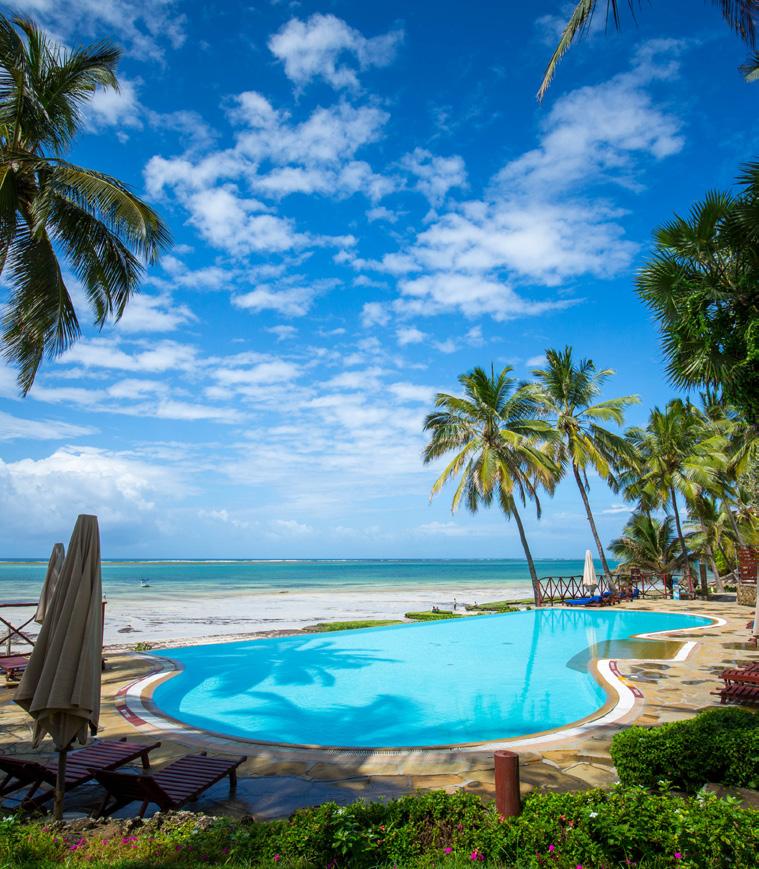
WELL-EDUCATED AND
PROFFESSIONAL HUMAN CAPITAL
Kenya has a large pool of young, talented, highly educated, skilled and most sought-after work force in Africa.
•
The World Economic Forum’s country competitiveness report ranks Kenya 1st in Africa in quality of human capital, availability of research and innovation.
• Kenya was ranked among the top 10 sub-Saharan economies leveraging their human capital in 2018 by the World Economic Forum.
This is Kenya 10
DIVERSE INSTITUTIONS OF HIGHER LEARNING
Kenya’s universities, colleges, medical schools, engineering schools, and law schools are well-known and regarded in the education and academic worlds, and they continue to provide competitive undergraduate, Master’s, and Ph.D. programs for dedicated students. Institutions of higher learning in Kenya include;
• University of Nairobi. Kenyatta University. Strathmore University.
• Moi University.
• Jomo Kenyatta University of Agriculture and Technology. Egerton University.
The Catholic University of Eastern Africa.
• United States International University Africa.
• Mount Kenya University.
CONDUSIVE BUSINESS ENVIRONMENT
Kenya is ranked 56th out of 190 economies in the Ease of Doing Business Index with an ambitious plan to reach top 50 in the next 3 years.
• Investors can easily start businesses in Kenya as the registration capacity has boosted by improvements in cost, time and the number of procedures required to start a business.

• Well established private sector and a strong mix of local and foreign investors in diverse industries.
• Foreign companies are investing in Kenya and setting up local and regional operations to take advantage of Kenya’s strategic location, comprehensive air routes, and status as a regional financial centre.
• Availability of labour with Kenya having a large, highly educated and skilled talent pool (Kenya population comprises of 55% of people between 15-64).
• Kenya has a market-based economy and is generally considered the economic, commercial, and logistics hub of East Africa
11
SECTION 3:


KEY EXPORT PRODUCTS AND SERVICES
Kenya is the premier source of quality horticultural produce, grown in natural conditions under the sun and delivered to markets through the best cold-chain logistics network in the world. She is a Major supplier of;
• Flowers and ornamental roses in the world exporting to over 60 destinations. Kenyan flowers are world renowned with unique characteristics such as novelty, longer shelve lives, diverse and beautiful.
• Fresh vegetables such as French beans and peas to the world especially the EU Market.
• Fruits such as avocadoes, mangoes and pineapples and edible nuts (macadamia and cashew nuts) to the world.
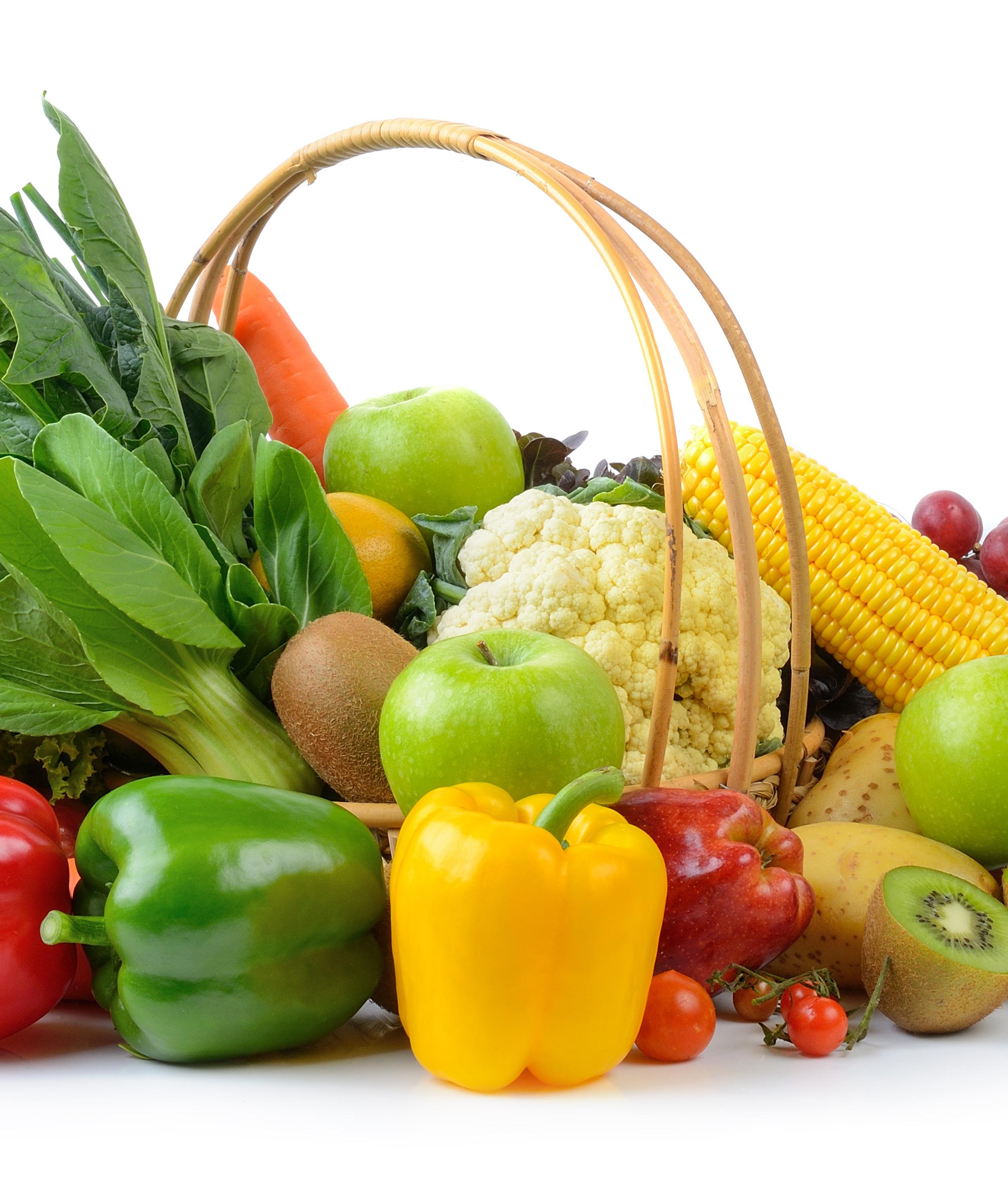
The success of Kenya’s Agribusiness Sector is attributed to;
Reputable quality products due to compliance in international market requirements both legislative and non-legislative due to the commitment by the industry to meet the highest stringent quality specifications done under good agricultural practices guided by global G.A.P specifications with a full traceability system in place.
Reduced rejections of fresh produce at the destination ports.
Kenya has unique competitive advantages for commercial horticulture –climatic variation, export market credibility, diverse product range, postharvest facilities.
Backward linkages to the small holders at firm level, translating into gains in terms of income and contribution to employment and poverty reduction.
Many smallholders have been integrated into global value chains reducing costs and risks.
Efficient dissemination of technical and market intelligence information ensuring well informed producers in the industry especially on good agricultural practices.
Increased confidence in Kenyan horticultural products in the global market and increased market entry into key markets in developed countries. Increased uptake of KEPHIS technical capacity in sanitary and phytosanitary services with an enhanced international, regional, and national recognition of KEPHIS as an eminent testing body.
Increased exporter awareness to adopt value addition especially in flowers (ready packed in bouquets).
FLOWERS
Kenya prides herself of a blooming flower sector. Kenya is Africa’s lead exporter of flowers and ranks as the third largest exporter of flowers globally. The most significant markets for Kenyan flowers are the European Union, United States of America, United Kingdom, Russia, Australia, Asia and Africa.

Production
Kenya produces roses, carnations, alstroemeria, gypsophila, lilies, eryngiums, arabicum, hypericum, statice, and other summer flowers. Kenyan flowers grow in pure volcanic soils in high altitude areas, which is the secret behind the premium quality. However, the main ingredient is the love, care and nurture they receive from the onset, through the hands of happy workers whose livelihoods have been completely transformed by the flower industry.
Attributes
• Kenyan flowers are world renowned with unique characteristics such as novelty, longer shelve lives, diverse and beautiful.
• Kenya’s flower exports have grown in volume and value over the years with roses having the most demand worldwide.
VEGETABLES
The wide geographical and climatic diversity together with complementary irrigation has allowed production of vegetables throughout the year that target both local and international markets.
Production
Vegetables grown in Kenya include tomatoes, cabbage, kales, garden peas, French beans, spinach, snow peas, carrots, pepper, snap peas, butternut, broccoli, runner beans, courgetti, cauliflory, beetroots, baby corn, radish, sweet corn, lettuce and turnips.
Asian vegetables grown in Kenya include eggplant, dudhi, okra, karella, tindori, turia and valor. The country is also producing aromatic plants which include; bulb onions, spring onions, coriander, garlic, long cayenne, bixa, rosemary, stevia, lemongrass, bullet chilli, parsley, ginger, chives, leeks, turmeric, basil, vanilla, celery and jatropha.
Attributes
• Vegetables farming in Kenya continues to attract investors due to the solid infrastructure, favourable climate, global positioning of Kenya and productive workforce.
• Vegetable farmers comprise of large, medium and small-scale producers who have attained high management standards and have invested heavily in value addition through adoption of modern technology in production, precision farming and marketing.
• Kenya exports vegetables to Pakistan, Netherlands, United Kingdom, Egypt, and United Arab Emirates.
FRUITS
The Kenyan weather is conducive for a variety of fruits to thrive because it can accommodate different types of fruits for better yields. Fruit farmers in Kenya have several options on the type of fruits to venture in depending on their investment plan.
Production
The fruits grown in Kenya include banana, mango, pineapple, avocado, watermelon, pawpaw, lime, orange, purple passion, yellow passion, tree tomato, lemons, guavas, tangerine, loquats, pears, grapefruit, grapes, plums, sweet melon, custard apple, strawberries, apples, thorn melon, peaches, pepino melon and jackfruit.
Attributes
• Farmers utilise modern technologies some of which includes drip irrigation, fertigation systems, greenhouse ventilation systems, net shading, fertilizer recycling systems to prevent wastage, use of wetlands for wastewater treatment, artificial lighting to increase day length for long day crops, and post-harvest handling facilities and techniques.
• Kenya’s top export destinations for fruits include Netherlands, USA, United Arab Emirates (UAE) and France.
This is Kenya 13
NUTS
This subsector is important as a source of processed edible oil, animal feed and industrial oil. The scheduled nuts and oil crops in Kenya include coconut, Cashew nuts, Macadamia, Oil palm, Sunflower, Sesame, Castor, Canola, Peanuts, Bambara nuts, Sunflower, jojoba, linseed (flax seed).
MACADAMIA
Macadamia nuts are mainly grown in the central part of Kenya such as Muranga, Kiambu, Kirinyaga, Embu and Meru. These are the places that the tree was first introduced when it came into Kenya. With time, the tree has spread to other areas of the country such as Bungoma, Kakamega, Kitale, Machakos and Taita Taveta.
Production
Kenya is the third largest exporter of macadamia after Australia and South Africa. It is grown by an estimated 200,000 smallholder macadamia farmers across the country while the rest is cultivated under plantation farms.
Kenyan macadamia nuts are grown in the mineral rich highlands. Macadamias will grow on a wide range of soils but perform best on welldrained soils, preferably 1-2 m deep and high in organic matter.

Attributes
• There are two main varieties of macadamia grown; Integrifolia and tetraphylla M. Tetraphylla is preferred for its ability to germinate uniformly, grow faster, and are considered somewhat easier to graft and transplant and produces slightly spindle shaped nuts.
• Macadamia is considered the world’s finest dessert nut because of its delicate taste and numerous health benefits; it is the king of nuts.
• Nuts are enjoyed in various ways, with the most popular being an exciting gourmet snack. It can be enjoyed as roasted and salted table nuts, honey coated or chocolate covered nuts. Macadamia nut chips are blended into breads, cookies, biscuits, pastries, icecream, bakery toppings etc.
CASHEW NUTS
Cashew nut is among the oldest cash crops in the Kenyan Coast and a major source of income for smallholder farmers mainly in Kilifi, Kwale, Mombasa, Tana River and Lamu Counties.
Production
The Crop is also grown in Tharaka Nithi County and expansion is ongoing to other parts of Eastern region. The tree is fairly drought resistant and grows well even on marginal soils where other fruit trees would fail. The best soils for growing cashew are Well drained, deep (2-3m) sandy soils. Cashew is a drought tolerant crop requiring a minimum of 500mm per annum 1,000 mm is sufficient for production. Average of around 25C is ideal temperature.
Attributes
• Kenyan Cashews are low in sugar and rich in fiber, heart-healthy fats, and plant protein.
•
They’re also a good source of copper, magnesium, and manganese — nutrients important for energy production, brain health, immunity, and bone health.
• Broken kernels are used in confectionery and sometimes as substitute for almonds. Ground cashew kernels can replace peanut butter in exotic dishes.
TEA Production
The country’s tropical climate and deep reddish soil (high mineral content) is perfect for making tea bushes thrive and producing the best tea. Tea bushes are grown at high altitude of over 8,000 feet and this contribute to the higher antioxidant levels contained in the leaves.
The tea plants are nourished year-round sunshine and abundant rainfall. The tea leaves are moist, and they grow all year round. Farmers pluck the tea carefully, tender apical portions of the shoots, two leaves and one new bud, which is good for a fine black tea. The leaves are gathered, dried and cut to be packed into loose leaf bags or teabags.
Tea processing facilities in Kenya meet local and international quality standards and are certified. Kenyan tea production complies with sustainable and trade practices and have most of the private certification such as fair-trade certification, Rainforest Alliance Certification, among others.
Kenyan tea has a distinct taste and quality; has a bright amber colour and a full-bodied flavour.
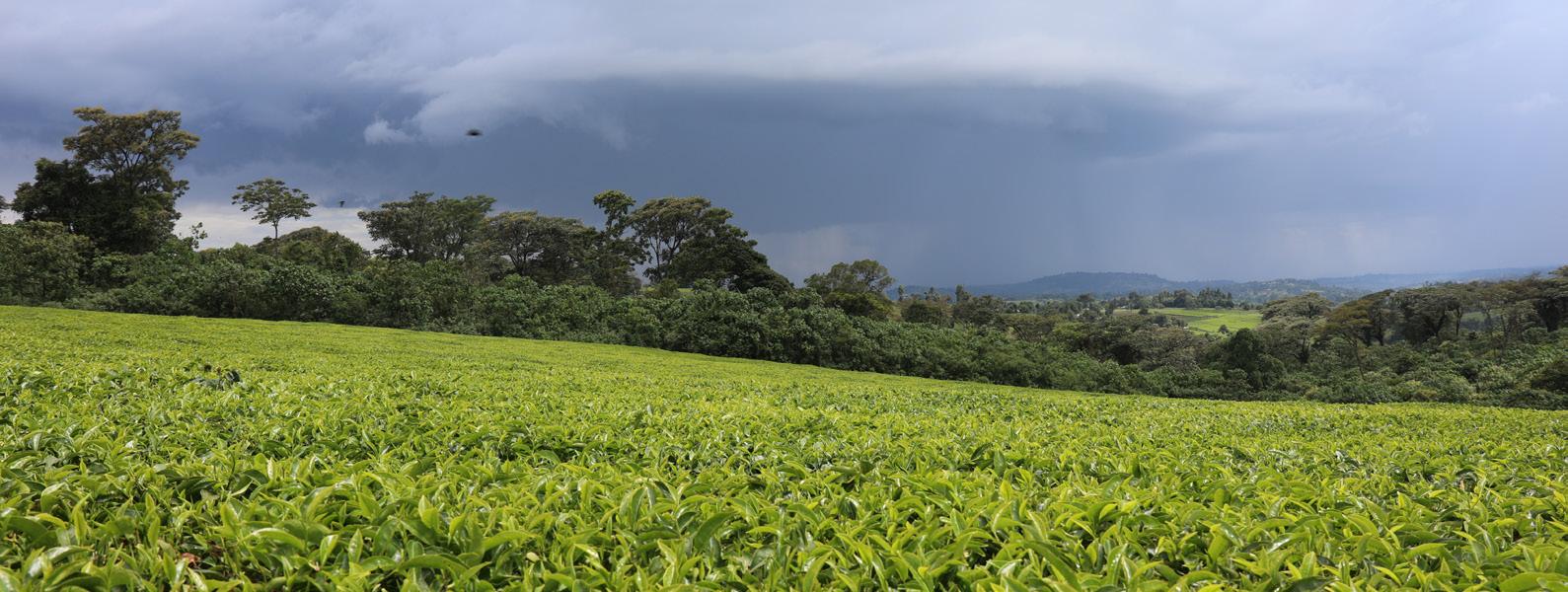
This is Kenya 14
Attributes
Kenya tea is of high quality and safe due to;
Adherence to good agricultural practices (no pesticides or agro chemicals).
• Good husbandry practices and selection of high-quality varieties. Skilful processing practices (no additives, preservatives or artificial colouring).
• Continuous improvements due to investment in modern technology and R&D; commitment to Global and National Food Safety stan dards (ISO, HACCP, KS1927).
Compliance with environmental and social market requirements (Ethical Tea Partnership (ETP), Fair Trade, among others). Kenyan farmers also maintain sustainable practices so as not to negatively affect Kenyan natural resources as well as diminish the quality of their tea.
COFFEE
Production
All Kenya coffee is Arabica coffee grown on the rich volcanic soil found in the highlands of the country, 1400-2000 meters above sea level, and harvested during the months of October through December. Most of Kenyan coffees are produced by smallholding farms. The farmers pick up the ripened cherries to be de-pulped and to take out the crust of coffee beans.
The beans are then fermented to get rid of their sugary coating called the mucilage, and dried on the patios, turned and tossed frequently so that some moisture is retained, and the coffee beans get the desired bluish colour. After they are fully sun-dried and milled, the coffee beans are destined for bulk trade.
Kenyan coffee is medium roasted, robust and sophisticatedly crafted coffee beans that are revered for their highest grade on the rating scales. Kenyan coffee, with its rich body, has high acidity, intense flavour, delightful aroma and lingering the complex sweetness.
Attributes
• The majority of Kenyan coffees are produced by smallholding farms by the skilled farmers who tend to the crop. All Kenyan green coffee beans go through the process of pulping and wetting. The wet process ensures the beans’ smooth and the less acidic feel.

• Kenyan coffee is among the best in the world because of its rich body, high acidity, intense flavour, and delightful aroma.
• Black current is a flavour that is distinct to Kenyan beans, and one of the reasons a cup of coffee from Kenya tastes so unique.
TEXTILE
The clothing and textile industry in Kenya plays an important role in the industrialization of the country. This is because of the industry’s unique characteristics of being labour intensive and its links with other sectors of the economy such as agriculture.
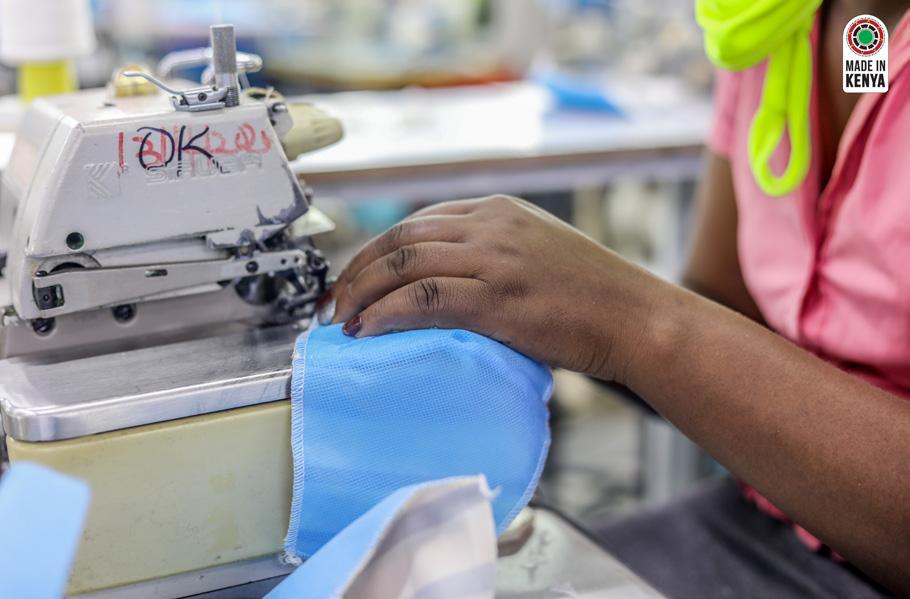
Production
Kenya currently produces an average of 25,000 bales of cotton. It is estimated that approximately 40,000 farmers are involved in cotton farming, while the overall sector provides livelihood to approximately 200,000 households.
Cotton in Kenya is mainly grown by about 30,000 to 45,000 smallholder farmers in arid and marginal regions, under rain-fed conditions on small land holdings of about one hectare.
Cotton is drought tolerant and is mostly grown by small-scale farmers in semi-arid regions in the country. It takes about 6 to 8 months to mature. In Kenya, cotton is sown between April - June and harvested from November - February.
Attributes
•
The cotton, textiles, and apparel (CTA) industry is Kenya’s secondlargest manufacturing industry after food processing and has been classified as a core industry.
• Kenya’s CTA manufacturing value chain comprises researchers, ginners, farmers, spinners, input suppliers, textile manufacturers, and extension service providers.
• Kenya is in a strong position to capitalize on the African Growth and Opportunity Act (AGOA) agreement as the country already captures more than a third of all apparel exports from SubSaharan Africa to the USA. 70% of Kenyan apparel firms have a US dominant market orientation.
LIVESTOCK
Livestock comprises dairy cattle, goats, camels and beef cattle, small ruminants, non-ruminants, poultry and emerging livestock such as quail and rabbits.
Beef is largely produced in arid and semi-arid areas, where about 36 percent of the Kenya population live. Dairy production is concentrated in high potential agro-ecological zones where fodder and pastures are available.

This is Kenya 15
The country has an estimated 43.8 million chicken contributing 5.1 percent of the livestock.
The poultry sector is highly heterogeneous and produces more than 35000 tonnes of meat and 1.6 billion eggs annually.
Production
Dairy farming in Kenya is the largest Agricultural sub-sector compared to other Agricultural farming. It contributes to about 14% of Gross Domestic Products in Agricultural sector and when combined to Kenya National Goods Domestic Product it produces 3.5%.8 May 2021. Milk production in the country includes 4.6 billion litres from cattle, 6.4 million litres from goats and 340 million litres from camels providing an important source of livelihoods to Kenyans.
Approximately 88% of Kenya’s livestock is produced in arid and semiarid areas. Out of those, only 14% are commercially traded in the market whereas the rest are reared for social and cultural reasons.
Over 225,000 households (over 1.5 million people) have access to improved livestock markets, out of which 175,000 households (1.2 million people) have seen their incomes improve.
Attributes
• Kenya Meat Commission procures all its raw materials for its processes with due consideration of high-quality standards at all times. Strict procedures in livestock procurement/sourcing are adhered to.
• Stringent Veterinary inspections of the animals in the field, ante-mortem inspections at the point of receipt, postmortem inspections during the slaughter process and at dispatch of the products are adhered to. This ensures that quality is taken care of from sourcing through processing to distribution of all the Commissions’ products.
• The Commission has continued to maintain high levels of food safety, product quality and hygiene. The Commission has a fully-fledged in-house laboratory for monitoring compliance of production processes and finished products.
• Slaughtered beef carcasses are chilled for a period of minimum 48 hours during which temperature and humidity are monitored closely. The process is meant to relax the muscles and consequently achieve aged or cured beef which is tender and has a superior taste. This is a key attribute that distinguishes the Commission’s meat from others
MEDICAMENTS
Kenya is currently the largest producer of pharmaceutical products in the COMESA and EAC region. This can be attributed to our capacity to deliver quality equipment, favorable government policies allowing for mass production of high-quality medicine, and the availability and willingness of both local and foreign investors in the manufacturing space.

Production
Medicines manufactured in Kenya are targeted at Anti-Infective, Gastrointestinal, Analgesic/Anti-inflammatory, Cardiovascular and Respiratory therapeutic segments.
The types of medical equipment manufactured meet the demands of the market. Kenya’s goal for the future aligns with World Health Organization’s goal to reduce the price of medicines and the supply time globally.
Attributes
• Kenya has more than 40 pharmaceutical manufacturing companies, including pharma giant Square Pharmaceuticals, who have installed one of the largest manufacturing plant in Africa.
• Kenya enjoys favorable Government policies in the pharmaceuticals sector.
• Strict regulatory policies for manufacturers of medical equipment ensure quality and adherence to the Good Manufacturing Practices (GMP).
This is Kenya 16
EXPORT OF SERVICES
FINANCIAL SERVICES
The Financial Services Sector (FSS) is one of the 6 priority sectors under the economic pillar of Kenya Vision 2030 that are expected to play a critical role in ensuring the country attains a 10% Gross Domestic Product (GDP) growth rate by the year 2030. Kenya has 43 banking institutions (42) commercial banks and 1 mortgage finance company), 9 representative offices of foreign banks, 13 Microfinance Banks (MFBs), 3 credit reference bureaus (CRBs), 19 Money Remittance Providers (MRPs) and 73 foreign exchange (forex) bureaus.
across borders as Kenya pushes forward in developing its health tourism.
Kenya as a key player in the global telecommunication services trade, which the WTO estimates to be worth over US$ 1.5 trillion in revenue, with 45% of this being accounted for by mobile services. It is therefore no coincidence that the ICT services sector in Kenya has been ranked among the fastest growing sectors globally.
Kenya’s Safaricom is the first private telecommunications operator in Ethiopia.
HEALTH SERVICES
Equity Bank operates in five regional markets Uganda, Tanzania, Rwanda, South Sudan and Democratic Republic of Congo.
KCB Bank headquarters are in Nairobi, Kenya, with its subsidiaries being KCB Bank Kenya Limited, KCB Bank Burundi Limited, KCB Bank Rwanda Limited, KCB Bank South Sudan Limited, KCB Bank Tanzania Limited, KCB Congo and KCB Bank Uganda Limited.

EDUCATION SERVICES
Kenya is already participating in the global trade in education services as illustrated by the increasing number of foreign students coming to Kenya for higher education. The country is however well positioned to enhance education services exports as evidenced in the education sector’s vision, which seeks to ensure the sector positions itself as “a globally competitive education, training, research and innovation system for sustainable development.”
The United States International University Africa (USIU), the University of Nairobi, Kenyatta University, Moi University, Jomo Kenyatta University of Agriculture and Technology and Egerton University are the top five best choices for international students.
INFORMATION COMMUNICATION AND TECHNOLOGY (ICT) SERVICES
Kenya is among the few African countries that is exporting software development services to global technology firms from USA, India, South Africa, Spain, Germany among other countries. ICT business to business innovations can be used to facilitate e-health and telemedicine where facilities such as radiology machines and human resources such as doctors are shared across distributed hospitals, within the country and
The health sector comprises the public system, with major players including the Ministry of Health and parastatal organisations, and the private sector, which includes private for-profit, Non-Governmental Organizations, and Faith Based facilities.
Health services are provided through a network of over 4,700 health facilities countrywide, with the public sector system accounting for about 51 percent of these facilities. The public health system consists of the following levels of health facilities: national referral hospitals, provincial general hospitals, district hospitals, health centres, and dispensaries.
The Aga Khan Hospital is based in Kenya and has branches in Dar es Salaam, Mumbai, Kisumu, Mombasa and Pakistan.

TRANSPORT SERVICES
Kenya’s transport sector accounts for 8.3% of its total GDP. Its public transport system is privately operated with the road transport network served by matatus (minibuses), taxis (traditional and ride hailing services), boda-bodas (motorcycles) and tuk tuks (three-wheelers).
The aviation transport service offers domestic and international flights handling both cargo and people. It is served by the Jomo Kenyatta International Airport, Moi international Airport, Kisumu International Airport, Eldoret Airport and Wilson Airport.
The maritime transport service is a key pillar of the Kenyan economy. The Port of Mombasa as well as the newly constructed port of Lamu serves as the entry and exit point for cargo not only for Kenya but for neighbouring countries as well signalling Kenya is open for business.
This is Kenya 17
INSURANCE SERVICES

• Kenya represents one of Africa’s most well-developed and best-regulated insurance markets. In recent years, insurance penetration and accessibility have been improving steadily in Kenya. The middle class is growing, more Kenyans have disposable income and there is potential for new demand for insurance.
• Kenyan insurers have expanded into neighbouring East African countries in the past decade. Britam has subsidiaries in Uganda, Tanzania, Malawi, Mozambique, South Sudan and Rwanda. ICEA Lion operates in Uganda and Tanzania. CIC Insurance Group provides insurance and related financial services in Uganda, South Sudan and Malawi.
INWARD INVESTMENTS
Kenya is among the world’s emerging economies to invest in, due to its accelerated infrastructure development and a stable political and macroeconomic environment. Favorable investment policy empowered by a new constitution and administration, the national and county Governments work with the private sector as a central partner in the development and growth of the Kenyan economy.
Kenya stands out to leverage on its diversified economy that is increasingly attracting inflows from a strong service sector with Foreign Direct Investment (FDI) flowing in from emerging and developed markets.
This is Kenya 18
4: OTHER OPPORTUNITIES FOR INVESTMENT



SECTION
MINING SECTOR
Kenya is rich in mineral resources with known deposits of soda ash, fluorspar, titanium, gold, coal, manganese, iron ore, gypsum, diatomite, chromite, limestone, and silica sand. There are also indications that the country is potentially rich in rare earth minerals and other types of minerals which are to be discovered with increased exploration.
SUSTAINABLE BLUE ECONOMY
According to the World-Wide Fund for Nature data, globally the Blue Economy has an asset base of over $24 trillion. It is said to generate at least $2.5 trillion each year from the combination of fishing and aquaculture, shipping, tourism, and other activities. The total “ocean asset base” of the Western Indian Ocean region spanning from Somalia to South Africa is at least USD333.8 billion and the annual “Gross Marine Product – GMP” (equivalent to a country’s annual gross domestic product (GDP) – is at least USD22.9 billion.
Kenya has a share of about 2.4 billion USD of this Western Indian Ocean economy. With Coastal Tourism taking the largest share of about $1.5 billion annually. Compared to the annual GDP of about $60 billion for the country, this is only a five percent contribution to the GDP. Kenya’s lucrative tuna belt is estimated to be 170,000 – 330, 000 Metric tonnes of fish in her expansive Exclusive Economic Zone (EEZ).
VALUE ADDITION IN AGROPROCESSING
The Kenya Vision 2030 underscores value addition as one of the priority areas under the economic pillar. Value addition of commodities implies increased net returns to farmers and growth of other multiplier benefits from further processing into higher value products and by-products (e.g. employment in processing, forward and backward linkages with other service and complementary raw material suppliers etc). Kenya has prioritized and build capacity in product value addition in six value chains: coffee, horticulture, honey, fish, milk and mangoes.
SPECIAL ECONOMIC ZONES
Kenya aims to transform Kenya into a newly industrialized ‘middle-income country providing a high-quality life to all its citizens by the year 2030.’ The establishment of Special Economic Zones is Key to the achievement of this vision. Special Economic Zones in Kenya offer incentives to investors such as duty exemption, protection and repatriation of profits, tax exemptions and work permit facilitation.
AGRICULTURE
Agriculture plays a pivotal role in Kenya’s economic development as evidenced by its 26% direct contribution to the Gross Domestic Product (GDP) and 27% indirect contribution to the GDP through linkages with other sectors.
The sector is also a major source of livelihood through its employment of more than 40% of the total population and more than 70% of Kenya’s rural people. The sector has continued to grow at almost 5% per Annum and has a huge potential for further growth.
The lead export products which presently account for over 90% of agricultural exports include the following: horticulture (cut flowers, fruits, vegetables, herbs, spices and nuts), coffee, tea, pulses, pyrethrum extract, and sisal products.

ENERGY
Kenya has one of the most developed power sectors in sub-Saharan Africa, having opened its market to Independent Power Producers (IPPs) in the mid-1990s. Kenya benefits from factors including: an active private sector, Kenya Power’s long track record as a creditworthy off-taker, and abundant renewable energy resources, especially geothermal, wind and solar. Kenya’s current installed capacity is 2,351MW out of which Hydroelectric is 40%, Thermal is 36%, Geothermal 30% and Other Renewables: 2%. Out of this the current access rate is 75%
MANUFACTURING
The manufacturing sector plays a central role in Kenya’s economic growth, contributing an average of 10% of the Gross Domestic Product (GDP). The manufacturing sector has been singled out as one of the four pillars the Government of Kenya is looking upon for transforming the economy through industrial growth aimed at employment creation and poverty alleviation.
The sector features opportunities in textiles and apparel products, leather and leather products, chemical and allied industries, metal and allied products, pharmaceutical and medical equipment, agro-Processing Industry, automotive and parts industry and the plastics industry.
This is Kenya 20
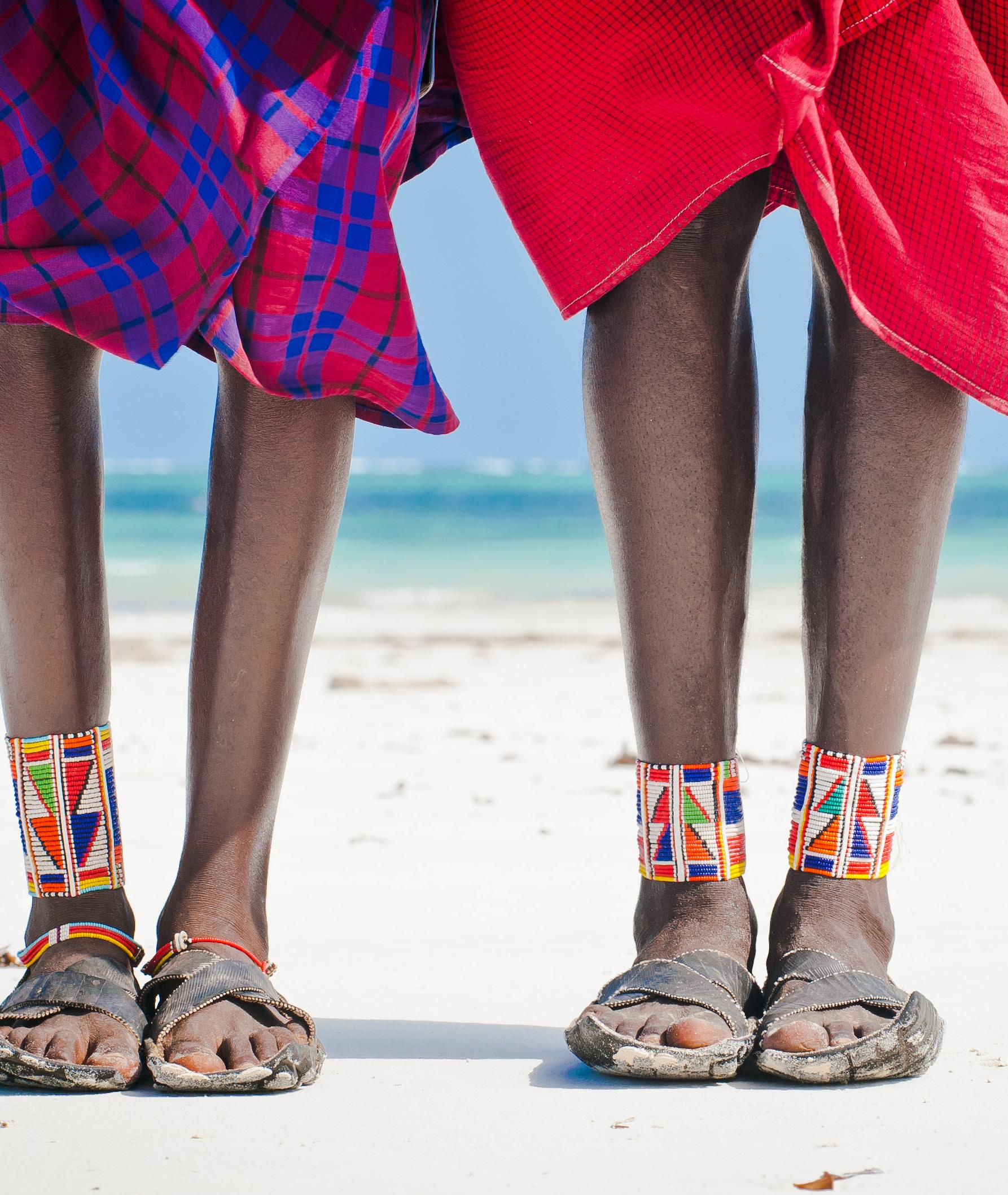


SECTION 5: KEY ATTRACTIONS IN KENYA ‘Come Live the Magic’
Come live the Magic!
KEY TOURIST ATTRACTION CENTRES
• Major tourist attraction sites include;
• Tsavo National Park. Chyulu Hills.
Kenya
is one of the world’s magnificent tourism destinations. Kenya is a year-round destination offering authentic, diverse and unique experiences, providing travelers with breathtaking moments of discovery wrapped with the warmth of its people. The popular wildlife migration in the Maasai Mara is one of the most sought-after experiences by long-haul Chinese travelers.
But Kenya is the land of diversity and invites you to enjoy unique experiences beyond the migration season. Destination management companies offer custom-made itineraries to provide such experiences.
Its parks, reserves and private conservancies are home to some of the highest and most diverse populations of wildlife on the planet.
Beach tourism, eco-tourism, cultural tourism, and sports tourism are all part of the tourism sector in Kenya.
Kenya is world renowned as the safari destination and is home to the twin migration of the Humpback whales and Wildebeests. The destination has been awarded “the world’s leading safari destination” by the Oscars of the travel industry; World Travel Awards (WTA).
Kenya has the world`s only wildlife park within its capital city and home to the Big 5 - Elephant, Rhino, Buffalo, Lion and Leopard; the special 5 in Northern Kenya - the Gerenuk, the Somali Ostrich, the Reticulated Giraffe, the Grevy’s Zebra and the fringe eared Oryx. Kenya is also a birding paradise with over 1,100 recorded species of birds within Lake Baringo, Lake Nakuru and Lake Elementaita which are great spotting locations.
For the adventurous at heart, inspiring locations await trekkers for scenic views and experience with nature e.g., Chyulu Hills, located in Eastern Kenya within Tsavo National Park, and the trek along the heights of the Aberdares Ranges.
Other unique locations are the Northern Kenya’s spectacular Loroghi Hills, the wild Matthews Ranges and Ndoto Mountains. Further North, visitors can enjoy the cultural festivals and shores of Lake Turkana, which is both the world’s largest permanent desert lake and the world’s largest alkaline lake.
• Lamu Island.
• Amboseli National Park.
• Masai Mara National Reserve. Aberdare Ranges.
• The Great Riftvalley.
• Nairobi Safari Walk.
• Mt Kenya. Nairobi National Park.
• Samburu National Reserve.
• Kakamega Forest.
• Buffalo Springs National Reserve. Meru National Reserve.

• Wasini Island.
• Mt Longonot.
• Shaba National Reserve.
CULTURE AND HERITAGE
Kenya is a country of deeply rooted traditions and vibrant cultural crossroads. Some of the oldest evidence of human culture has been discovered in Kenya, making it truly a cradle of humanity. Today, Kenya is a dynamic nation that links its prehistoric pasts to new cultural expressions in a land of breath-taking beauty.
Kenya’s diverse landscape stretching from snow-capped mountains to the Great Rift Valley, and from deserts to lakes, vast savannahs, lush forests, and a sparkling coast-are reflected in the diversity of Kenyan people and their traditions. Many communities thrive in areas that have sustained their unique ways of life for centuries, while others are adapting their customs in growing urban areas.
The people who live along Kenya’s coast share cultural practices with communities in neighbouring countries that also border the Indian Ocean. Inland, communities continue to share the great open spaces with some of the world’s most treasured wildlife. In rapidly growing urban centres, people of diverse culture intersect, resulting in dynamic and creative new forms of expression that further enrich contemporary Kenyan culture.
This is Kenya 22 TOURISM
SECTION 6: VISIT, TOUR, INVEST AND TRADE WITH US !



24
is
Kenya Export Promotion and Branding Agency
1st & 16th Floors, Anniversary Towers, University Way
P. O. Box 40247 – 00100 GPO Nairobi Kenya.
Tel. + 254 20 222 85 34-8
Cellphone: +254722 205 875 | +254734228 534
Email: chiefexe@brand.ke Website: www.makeitkenya.go.ke
Kenya Investment Authority
UAP Old Mutual Towers, Upper Hill 14th and 15th Flr
P.O. Box 55704-00200, Nairobi Tel: (+254) 730104200
Email: info@invest.go.ke www.invest.go.ke
The National Treasury
Treasury Building, Harambee Avenue
P.O. Box 30007-00100, Nairobi Tel. +254 20 2252299
Email: ps@treasury.go.ke
Website: www.treasury.go.ke
Vision 2030 Delivery
Secretariat KUSSCO Centre, 2nd Flr, Upper Hill. P.O. Box 52301 - 00200, Nairobi
Tel: +254-20-272 20 30, +254-20-272 22 004
Email: info@vision2030.go.ke
Website: www.vision2030.go.ke
Ministry of Foreign Affairs and International Trade,
Old Treasury Building, Harambee Avenue
P.O Box 30551 – 00100 G.P.O
NAIROBI, Kenya
Tel: +254 20 3318888
Email: info@mfa.go.ke
Website: www.mfa.go.ke
Ministry of Industrialization, Trade & Enterprise Development
Social Security House, Block A, 17th, 23rd Flr
P.O. Box 30418-00100, Nairobi, Kenya
Tel: +254 20-2731531
Email: ps@industrialization.go.ke
Website: www.industrialization.go.ke
Agriculture and Food Authority
Head of Coffee Directorate
Coffee Plaza, 10th Floor Haile Selassie Avenue
P.O Box 30566 – 00100 Nairobi
Telephone: +254 710 670 026, +254 788 494 579, +254 20 334 2717
Email: coffeedirectorate@gmail.com directorcoffee@agricultureauthority.go.ke
Website: coffee.agricultureauthority.go.ke
Presidential Delivery Unit
Physical Address: 24th Floor
Kenyatta International Conference Centre
P.O. Box 40530-00100 Tel: +254-20-2217774/3
Email: pdu@president.go.ke
Website: www.delivery,go.ke
LAPSSET Corridor Development Authority, Chester House Building.
P.O. Box 45008 - 00100, Koinange Street, Nairobi Tel: +254-(0)20-2218968 www.lapsset.go.ke
Ministry of Petroleum and Mining,
P.O. Box 30009 – 00100,
Phone: +254 (020) 2723101
Fax: 254 (020) 2714398
Email: cs@petroleumandmining.go.ke
Website: www.petroleumandmining.go.ke
This
Kenya
Ministry of Energy
Nyayo House 23rd floor, Kenyatta Avenue
P.O. Box 30582 - 00100, Nairobi
Tel: (+254) 020 310112
Cell: 0726 993 292, Fax: (+254) 020 2228314
Email: info@energy.go.ke
Website: www.energy.go.ke
Kenya Plant Health Inspectorate Service (KEPHIS)
KEPHIS Headquarters
P.O. Box 49592-00100, Nairobi
Tel: 020 661 8000
Email : kephisinfo@kephis.org
Website: www.Kephis.org
KENTRADE
First Floor Embankment Plaza, Longonot Rd, Upperhill Hill,Nairobi
P.O. Box 36943 - 00200, Nairobi
Tel: +254 (20) 4965000
Email: contactcentre@kentrade.go.ke
Website: www.kentrade.go.ke
Kenya Tourism Board
Head Office Kenya-Re Towers, Ragati Road
P.O. BOX 30630 – 00100 Nairobi,Kenya
Telephone: +254 20 2711 262Pilot No: +254 20 2749 000Fax: +254 20 271 9925
Email: info@ktb.go.ke
Website: www.ktb.go.ke
Kenya Revenue Authority
Times Tower Building, Haile Selassie Avenue
P.O. Box 48240 - 00100
Tel: +254 20 281 0000
Email: callcentre@kra.go.ke
Website: www.kra.go.ke
Immigration Department
Nyayo House 20th floor, Kenyatta Avenue/Uhuru Highway
P.O Box 30395 – 00100 Nairobi.
Tel: +254-20-2222022
Email; dis@immigration.go.ke
Website www.immigration.go.ke
Kenya Private Sector Alliance
5th Floor, Shelter Afrique Building, Mamlaka Rd. P.O. Box 3556-00100 Nairobi, Kenya
Phone +254 202730371|2|2727936|883
+254 720 340949|735 999979
Email: info@kepsa.or.ke
Kenya Association of Manufacturers
15 Mwanzi Road opp West Gate Mall, Westlands, Nairobi, Kenya
E: info@kam.co.ke
M: +254 (0) 722201368, 734646004/5
T: +254 (020) 232481
Kenya National Chamber of Commerce and Industry
Heritan House, Off Argwings Kodhek
Phone: +254 20 3927000
Email: info@kenyachamber.or.ke
Fresh Produce Exporters Association of Kenya
New Rehema House, 4th Floor Westlands, Nairobi, Kenya
P.O. Box 40312-00100, Nairobi T: +254 020 516 0333
E: info@fpeak.org
Kenya Flower Council
Suite 12, 4th Floor, The Greenhouse Building, Adams Arcade, along Ngong Road Tel. No: +254 20 2439523
Mobile: +254 733 639 523
Email: info@kenyaflowercouncil.org
This is Kenya 25
Konza Technopolis Development Authority (KoTDA)
Westlands, Capital West Business Centre
5th Floor, Opposite New Rehema House at the intersection of Rhapta Road & Lantana Road
P.O. Box 30519-00100
Nairobi, Kenya
Email: konza@konzacity.go.ke
Tel: +254(0) 204343013/4
Export Processing Zones Authority,
Administration Building,Viwanda Road, off Nairobi-Namanga Highway, Athi River, Kenya
P.O. Box 50563, Nairobi 00200, Kenya
Email: info@epzakenya.com
Safaricom :0709 537 000/ 0713-051172/3
Airtel: 0786-683222, 0733-683222
